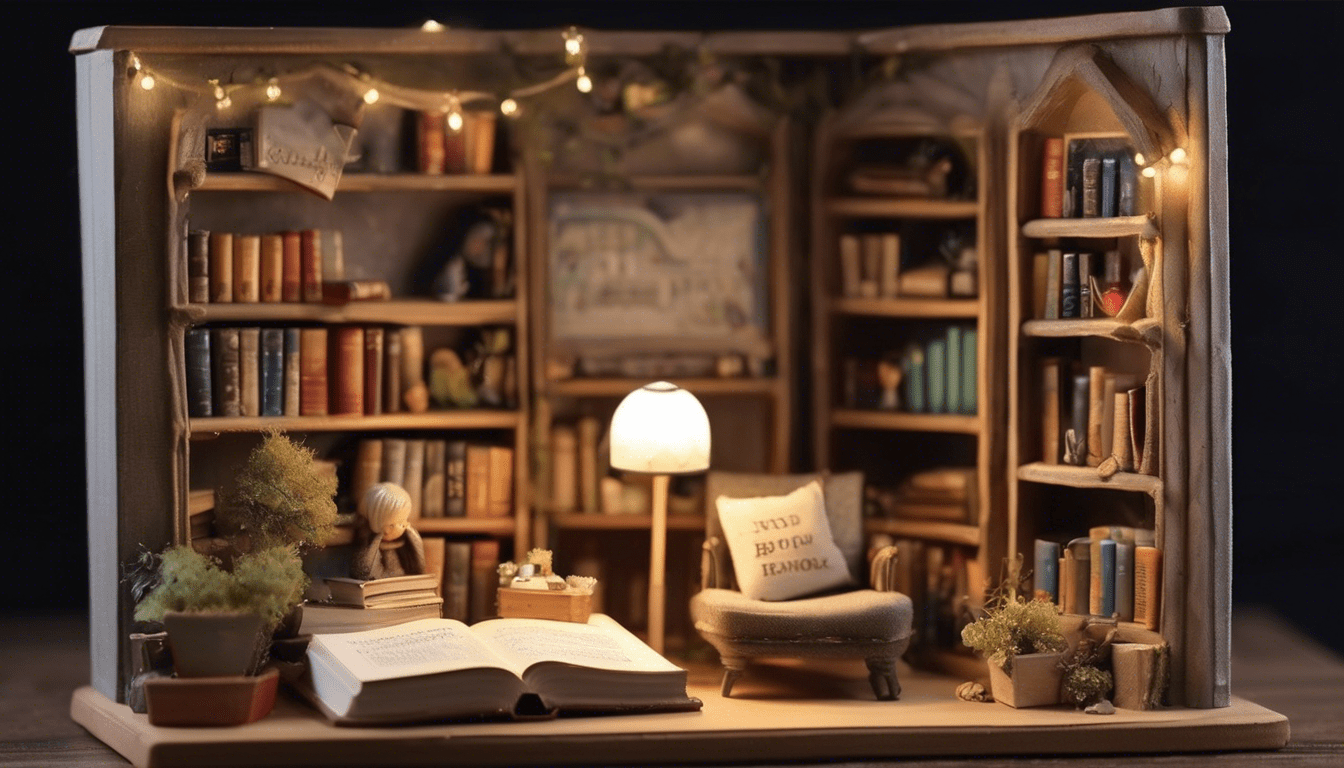For avid readers, a beautifully crafted book nook transforms a simple shelf corner into an immersive escape. These miniature worlds, blending art and storytelling, evoke a sense of wonder and personalize reading spaces uniquely. Whether DIY enthusiast or shopper, exploring stunning book nook miniatures invites a fresh perspective on how tiny details can deepen the reading experience and bring literary worlds to life right at home.
Introduction to Book Nook Miniatures
Bringing literature to life, one miniature scene at a time.
Also read : Top Strategies for Designing a Drought-Resilient Front Yard in the UK
Book nook miniatures are enchanting decorative inserts designed to fit snugly between books on your shelf, creating a captivating visual escape for avid readers. These tiny dioramas transform ordinary bookshelves into immersive environments that celebrate the worlds within your favorite stories. Instead of just holding your books, your shelf becomes a portal, inviting you to explore intricate miniature landscapes inspired by literature.
The appeal of book nooks lies in their ability to blend art and storytelling. By combining carefully crafted miniatures with vibrant lighting and detailed backgrounds, they foster a sense of wonder and curiosity. Reading spaces equipped with book nook miniatures shift from mere storage areas to unique realms that reflect your passions and personality.
In parallel : Luxury interior design monaco: crafting bespoke, elegant spaces
DIY book nook projects are becoming increasingly popular among enthusiasts. Building your own book nook allows for personal creativity and customization, from choosing a theme to selecting the perfect lighting and figurines. Enthusiasts find joy not only in displaying these miniatures but also in assembling them—a rewarding hobby that enhances the reading experience.
For those eager to explore further, discovering the artistry of book nook miniatures can be a captivating journey. Enthusiasts often share tips and showcase their creations, inspiring newcomers to embark on their own miniature adventures. To see inspiring examples and learn more about this trend, visit https://book-nook.us/.
Embracing book nook miniatures means enriching your reading space with charm and storytelling magic that goes beyond the pages.
Key Elements of Stunning Book Nook Miniatures
Exploring design, detail, and creative balance
Creating stunning book nook miniatures involves meticulous attention to architectural details, thematic coherence, and a harmonious blend of realism and creativity. A primary element is crafting detailed miniature landscapes and interiors that bring an imaginary world to life within a tight space. These miniatures often highlight fine elements like tiny windows, doors, staircases, and furniture, all meticulously assembled to mimic real-life architectural features at a smaller scale.
Adding thematic elements and personalized touches enriches the story conveyed by the book nook. Whether inspired by fantasy realms, vintage libraries, or cozy reading corners, the themes create immersive atmospheres. By selecting motifs aligned with the viewer’s interests or the narrative the book nook aims to share, creators invite curiosity and emotional engagement.
Balancing realism with artistic creativity remains crucial. While striving for authentic textures, such as wood grain on shelves or brick patterns on walls, designers also use imaginative details to capture viewers’ attention. For example, unexpected pops of color or whimsical figures can transform a simple scene into a captivating miniature world.
Materials and Tools for Creating Book Nooks
DIY Supplies and Crafting Essentials
Crafting book nooks requires a thoughtful selection of materials and tools, ensuring both creativity and durability. The core materials most commonly used include foam, wood, resin, and acrylics. Foam serves as a versatile base, easy to carve and shape, making it perfect for structural elements. Wood, prized for its sturdiness and natural aesthetic, forms the framework or detailed accents. Resin is favored for transparent features or durable miniatures due to its solid finish, while acrylics provide clarity and strength, especially for windows or light covers.
Essential tools to successfully build book nooks include cutters, which offer precision cutting for foam and wood; brushes for painting fine details; and adhesives strong enough to bond different materials without damage. Lighting fixtures are not only functional but elevate the ambiance within the nook, bringing miniatures to life with soft glows or spotlight effects.
For those embracing sustainability or seeking accessible options, hobbyists can explore eco-friendly foams, reclaimed wood, or biodegradable adhesives. Finding alternatives does not compromise quality but supports environmentally conscious crafting.
The art of assembling a book nook intricately blends these core materials and specialized tools. This combination fuels imagination and craftsmanship, allowing creators to produce unique, visually compelling miniature spaces. For a deeper dive into assembling distinctive decorative features, refer to https://book-nook.us/. This resource uncovers options for combining materials to achieve stunning effects.
Understanding these materials and tools is critical to both newcomers and seasoned crafters interested in the world of book nooks. The right selection not only shapes the final piece but determines how durable and visually striking the finished nook will become.
Step-by-Step Guide to Designing and Building a Book Nook
Creating a book nook begins with careful planning and sketching of the layout. Before any construction, it’s crucial to visualize the scene, considering the depth and perspective you want to achieve. This foundation helps ensure the dimensions and elements will fit perfectly within your bookshelf, emphasizing a sense of immersion and scale.
Once your design is complete, start assembling the base. Constructing interior features like walls, floors, and architectural details provides the structural backbone. Using materials such as wood or foam board allows for precise cuts and sturdy assembly. Attention to scale here is essential smaller, detailed parts bring authenticity to your miniature environment.
Adding details and scenes is where your creativity shines. Incorporating tiny furniture, books, and accessories enhances realism. Don’t forget to integrate techniques to create depth and perspective; layered backdrops, gradual size reduction of objects, and strategic lighting all contribute to the three-dimensional illusion. Lighting can be softly diffused or focused to highlight key areas, making your book nook visually captivating even in low-light conditions.
For an interactive experience, consider embedding moving parts or LED lights to breathe life into the scene. Thoughtful wiring and battery placement keep the installation tidy and functional.
This process can occasionally involve challenges like scale mismatches or cumbersome wiring. Overcoming these common pitfalls involves precise measurement, testing components before final assembly, and using flexible lighting options.
Inspiration from Existing Book Nook Designs
Exploring the creativity in miniature worlds
The charm of book nooks lies in the diverse styles that spark imagination and bring shelves to life. Fantasy landscapes often feature magical forests, mythical creatures, and glowing embers that capture a reader’s awe. Cozy cottages with warm lights and intricate details create an inviting atmosphere that complements quiet reading moments.
Urban and vintage city scenes serve as dynamic contrasts depicting bustling streets, flickering neon signs, or classic architecture. These book nooks provide a nostalgic or contemporary vibe, perfect for readers who enjoy stories set in vibrant cityscapes.
Nature-inspired landscapes and woodland settings offer serenity with tiny trees, flowing streams, and hidden wildlife. These designs evoke calm and connect readers to the natural world, enhancing the pleasure of storytelling.
The variety of style variations in book nook miniatures provides endless inspiration, making each piece a unique celebration of art and imagination. For those wanting to delve further, resources like https://book-nook.us/ can inspire personalized touches and discover the artistry involved in crafting these enchanting scenes.
Buying vs. DIY: Making an Informed Choice
When considering whether to buy or craft your own book nook miniatures, several factors come into play, each influencing your final decision. If customization is your priority, handcrafted miniatures offer unmatched flexibility. Creating a book nook yourself allows you to tailor every detail—from lighting to intricate décor—ensuring the piece perfectly complements your reading space. However, be mindful that DIY crafting demands a considerable time investment and some skill with miniature techniques and materials.
Conversely, purchasing ready-made book nooks provides a convenient alternative. Many reliable artisans specialize in crafting exquisite miniatures, combining quality and creativity without the time drain. You can find a wide range of styles and themes that appeal to various tastes and budgets. Yet, this convenience can come at a higher cost compared to DIY, especially when commissioning unique pieces.
Budget is a critical consideration. While DIY projects might save money on materials, unexpected costs or lengthy trial-and-error processes can add up. Buying from reputable vendors ensures quality and often includes customer support, but it might not suit more modest budgets. Balancing these trade-offs depends on your priorities of time, quality, and personalization.
Integrating Book Nooks into Reading Spaces
Enhancing your reading environment
Positioning your Book Nooks thoughtfully is key to maximizing their visual impact. Place them at eye level on your shelves, ideally between or beside your book collections, where they draw attention without overwhelming the display. Combining the miniature artistry with smart lighting—such as LED strips or small spotlights—illuminates the fine details and creates a cozy ambiance that invites readers to linger longer.
When integrating these artistic miniatures, balance is crucial. Pairing Book Nooks with complementary decor elements like vintage bookends, plants, or textured fabrics can create a harmonious reading space. This integration not only elevates the aesthetic but also makes your nook feel personalized and immersive.
Protecting your Book Nooks ensures longevity. To shield them from dust and damage, consider placing them inside glass-fronted shelves or using transparent acrylic covers. Regular, gentle cleaning with a soft brush or microfiber cloth prevents dust accumulation without risking harm to delicate parts. By maintaining these miniatures properly, you preserve both their beauty and their storytelling power for years to come.
Conclusion: Elevate Reading Environments with Unique Book Nooks
Creating a book nook is an exceptional way to transform any reading space into a captivating, personalized sanctuary. These tiny, intricate dioramas serve as both a visual delight and a source of inspiration, deeply enriching the atmosphere where books come to life. By incorporating miniature scenes, readers can enjoy an elevated ambiance that sparks imagination and fosters a love for storytelling.
Engaging in DIY projects for book nooks invites creativity to flourish. This process encourages thoughtful design choices, from selecting themes to crafting detailed elements, making the project as rewarding as the final product. For those seeking guidance or fresh ideas, a wealth of resources exists, offering tutorials, materials, and inspiration to elevate every creator’s journey.



